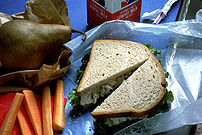What does it mean to challenge yourself, and what is the benefit?
To challenge yourself is to set a goal to do something that will not be easily accomplished. A challenge can be anything large or small. Sometimes it is easier to identify the larger challenges (bench press your weight, finish your school paper a week early, don't eat that chocolate, etc.), but it can be more difficult and require more creativity to exploit the smaller challenges, such as opening the door with your foot or optimising the way you close the bottle of milk. I believe that these smaller challenges are extremely important to understanding one's self. All self-challenges are great, I just think the small ones are underestimated.
If you challenge yourself to jump over a trash can, or to walk up the stairs only on your toes, or grab a bug out of mid-air with a pair of chopsticks, these are all intrinsic tasks that are performed by the fundamental "you"; they are not composite tasks based on reliance of others or your surroundings. Every time you complete a self-challenge, you've further defined another self-limitation. It would be great to find all of you physical limits via small challenges and know them all fully. This would give you a good picture of who you are and what you can accomplish (at least physically) and this will, in turn, allow you to get to know yourself even better.
There is no limit to the amount of information you can find out about yourself, so keep being creative and continue to find out your limits. As you test your limits, you will, at the same time be expanding your limits. Therefore, once you know your limit, try it again (and again and again and again), you may surprise yourself.
The below image set depicts the limit test, acquisition and challenge sequence. The solid circle represents your physical limit (for example, the absolute maximum distance you can jump), and the dotted circle represents what you interpret to be your limit via challenging yourself:

Fig.1: You have tested your limit and were easily able to complete the task. You are too far within your personal limits and are underestimating yourself. This is all too common in humans.

Fig.2: You have not properly tested your limit, and for some reason you have an altered perception that you can do more than you think you can. This is dangerous as it is an overestimation of your own ability.

Fig.3: This indicates "pushing the limits". Continually challenge yourself and dance around the line which dictates your absolute personal limitation. This will allow for an improved familiarity with yourself as well as work to increase your limits.
Leia Mais…
![Reblog this post [with Zemanta]](http://img.zemanta.com/reblog_e.png?x-id=0d6651e2-4e0c-41cf-b0cb-b50fad6bb32f)

![Reblog this post [with Zemanta]](http://img.zemanta.com/reblog_e.png?x-id=f459730e-bb76-4549-acf1-6bd58c4bd009)



![Reblog this post [with Zemanta]](http://img.zemanta.com/reblog_e.png?x-id=0fda73ad-c64c-4ca9-9420-96b190c9d048)


![Reblog this post [with Zemanta]](http://img.zemanta.com/reblog_e.png?x-id=3ba85730-2aee-4e06-945f-92a345832961)


![Reblog this post [with Zemanta]](http://img.zemanta.com/reblog_e.png?x-id=533d0adf-553a-4a97-9bee-2a17777294fa)
![Reblog this post [with Zemanta]](http://img.zemanta.com/reblog_e.png?x-id=b1419f5c-b92e-4bc0-9f08-72283f8bf4db)

![Reblog this post [with Zemanta]](http://img.zemanta.com/reblog_e.png?x-id=74d57357-2da6-4714-a40a-0e89b7c64c40)

![Reblog this post [with Zemanta]](http://img.zemanta.com/reblog_e.png?x-id=a5081c87-8067-4d6b-ad9d-3da4cd174bb4)

![Reblog this post [with Zemanta]](http://img.zemanta.com/reblog_e.png?x-id=f8a9a00b-05de-4dfc-862d-2f416aa7a5ff)

![Reblog this post [with Zemanta]](http://img.zemanta.com/reblog_e.png?x-id=791f4729-2b9c-4067-96b9-ba63173d602c)





![Reblog this post [with Zemanta]](http://img.zemanta.com/reblog_e.png?x-id=5aa2b2e9-11b5-4eab-8351-a45efda64755)

![Reblog this post [with Zemanta]](http://img.zemanta.com/reblog_e.png?x-id=ee94e947-5505-43e5-8942-fd8b3b837db1)
![Reblog this post [with Zemanta]](http://img.zemanta.com/reblog_e.png?x-id=9f0ec1d8-a3cd-4eaf-9e97-642bbdbd521e)

![Reblog this post [with Zemanta]](http://img.zemanta.com/reblog_e.png?x-id=28f0a267-2ab2-44d4-abfd-b10b3a30d971)

![Reblog this post [with Zemanta]](http://img.zemanta.com/reblog_e.png?x-id=45f3e065-2372-443c-8c80-f312055287b5)
![Reblog this post [with Zemanta]](http://img.zemanta.com/reblog_e.png?x-id=03620c09-76b8-4487-a918-0a5f79135c52)

![Reblog this post [with Zemanta]](http://img.zemanta.com/reblog_e.png?x-id=449c1001-14bc-4640-ae5c-af63235d327c)

![Reblog this post [with Zemanta]](http://img.zemanta.com/reblog_e.png?x-id=19a1d016-365f-4f83-ba7c-02654c9cb180)

![Reblog this post [with Zemanta]](http://img.zemanta.com/reblog_e.png?x-id=ddbe91de-e0b3-432e-8d83-ab779927b6c6)



